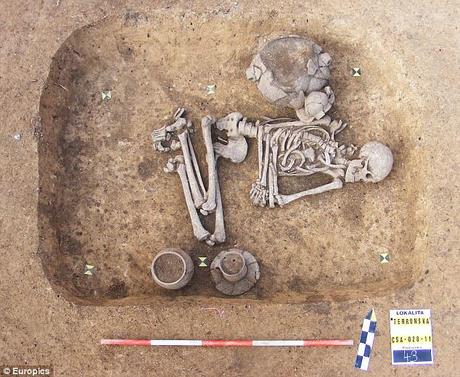This past week, British newspapers carried sensational headlines about an archaeological find in Prague: “First Homosexual Caveman Found” (The Telegraph) and “Oldest Gay in the Village: 5,000 Year Old is ‘Outed’ By the Way He Was Buried” (Daily Mail). Although the assemblage in question has not been published in a journal, the archaeologists called a press conference and provided this picture:

While this may not look very gay to the untrained eye, the archaeologists tell us this is an unusual burial because this apparent male was buried in a posture typically reserved for females, and because the grave goods are not typical of those usually found in either male or female burials. This raises the possibility that s/he was other gendered.
Although it is quite unlikely that modern Western constructions of gender or sexual orientation mirror those of 5,000 year old Neolithic farmers, the lead researcher nonetheless suggests an analogy: “Far more likely is that he was a man with a different sexual orientation, homosexual or transvestite. What we see here does not add up to traditional Corded Ware cultural norms.” While this may be an unusual burial for people of this time and place, determining sexual orientation and gender status from a single sample is fraught with difficulties, nearly all of which have been summed up nicely by Kristina Killgrove over at Bone Girl.
The find raises interesting questions, however, about what kinds of inferences we can make from burials. As my readers know, I question whether deliberate burials, with nothing more, is a marker for soul beliefs. Because nearly all people who bury their dead with grave goods claim that such goods assist the deceased in their afterlife journey, grave goods are a much better indicator of such beliefs.
But not all grave goods are created equal; when unusual objects are included, it may indicate that the deceased was a shaman. In 2008, Leore Grosman and colleagues described (in PNAS, open access) a 12,000 year old burial from the Levantine Natufian culture. The deceased, an elderly female, was buried with an unusual array of objects, including “50 complete tortoise shells and select body-parts of a wild boar, an eagle, a cow, a leopard, and two martens, as well as a complete human foot.” This suggested to the researchers that the old woman, who was physically debilitated for a long period of time before she died, was a shaman:
We argue that this burial is consistent with expectations for a shaman’s grave. Although the term shaman derives specifically from the Tungus people of Siberia, shamanistic figures are well-known from hunter-gatherer and small-scale agricultural societies world-wide. The shaman’s primary role is to mediate between the human and the spirit worlds. Shamans act as messengers, healers, and magicians, and serve both the community and its members.
Although shaman graves are highly variable, and thus, there are no standard criteria to identify a shaman in the archaeological record, a number of generalizations about shamans can be surmised from cross-cultural research: (a) shamans are associated with spiritual, magical, and healing powers; (b) shamans engage the help of spirits in animal form; (c) shamans are keepers of specialized knowledge; (d) shamans are ascribed high status within their communities; and (e) the status of shamans is reflected in their special treatment at death—their burials often contain artifacts reflecting their role in life (i.e., remains of particular animals and contents of healing kits).
Ethnographic records describe a variety of ways to bury a shaman (21), but because shamans are always considered privileged persons, who therefore enjoy a different kind of afterlife from other members of their group, unusual features of their graves mark their special status.
This is a splendid example of middle-range archaeological theory, in which known practices of historic or living peoples are used to assess archaeological discoveries and make inferences. In the case of the may be “gay” and not “caveman” burial from Prague, we have no such theory. We do not know, for instance, whether the Corded Ware culture recognized anything like a third gender, such as the Native American “two spirit” or berdache, and if so, whether such persons were buried in a differential manner.
In the absence of such knowledge and much more information about this burial and others from the same time/place, the most we can say is that this appears to be an unusual burial of uncertain significance. While it is never fun pouring cold scientific water on sensational headlines, it is sometimes necessary.
Reference:
Grosman, L., Munro, N., & Belfer-Cohen, A. (2008). A 12,000-year-old Shaman burial from the southern Levant (Israel). Proceedings of the National Academy of Sciences, 105 (46), 17665-17669 DOI: 10.1073/pnas.0806030105

